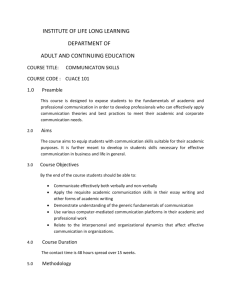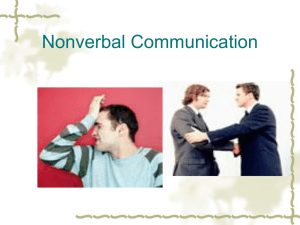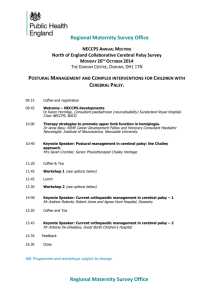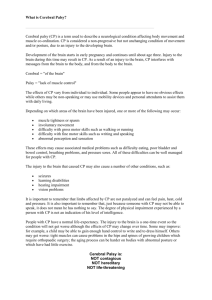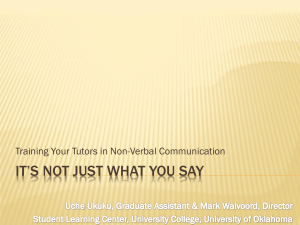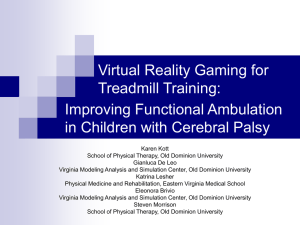digital games and assistive technology
advertisement
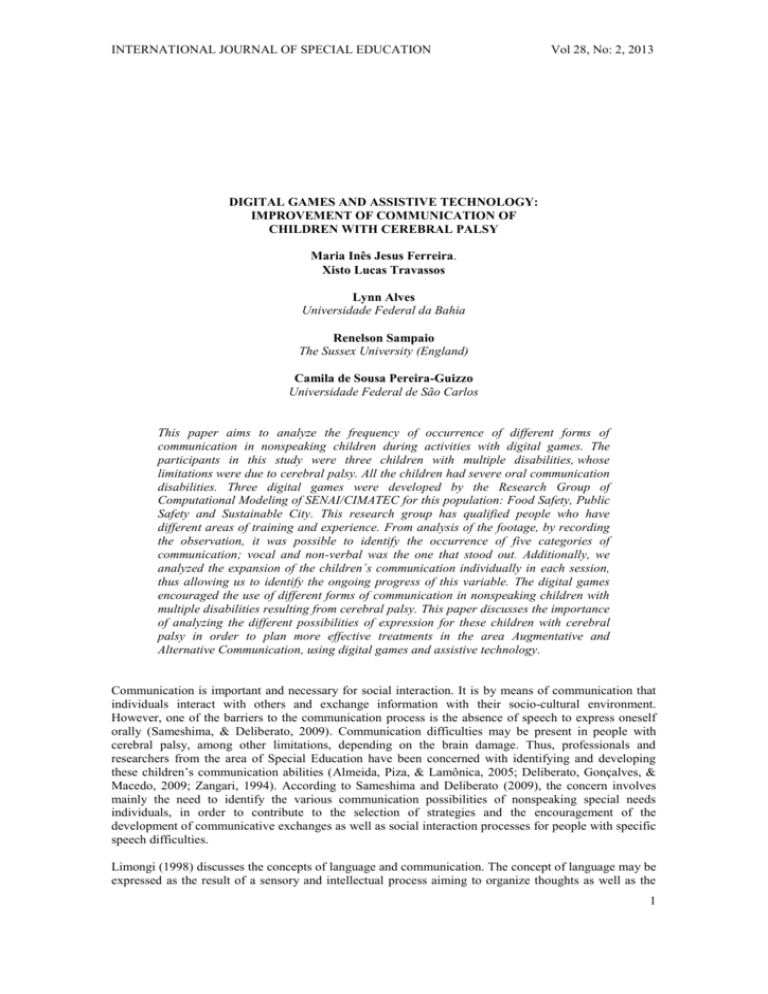
INTERNATIONAL JOURNAL OF SPECIAL EDUCATION Vol 28, No: 2, 2013 DIGITAL GAMES AND ASSISTIVE TECHNOLOGY: IMPROVEMENT OF COMMUNICATION OF CHILDREN WITH CEREBRAL PALSY Maria Inês Jesus Ferreira. Xisto Lucas Travassos Lynn Alves Universidade Federal da Bahia Renelson Sampaio The Sussex University (England) Camila de Sousa Pereira-Guizzo Universidade Federal de São Carlos This paper aims to analyze the frequency of occurrence of different forms of communication in nonspeaking children during activities with digital games. The participants in this study were three children with multiple disabilities, whose limitations were due to cerebral palsy. All the children had severe oral communication disabilities. Three digital games were developed by the Research Group of Computational Modeling of SENAI/CIMATEC for this population: Food Safety, Public Safety and Sustainable City. This research group has qualified people who have different areas of training and experience. From analysis of the footage, by recording the observation, it was possible to identify the occurrence of five categories of communication; vocal and non-verbal was the one that stood out. Additionally, we analyzed the expansion of the children´s communication individually in each session, thus allowing us to identify the ongoing progress of this variable. The digital games encouraged the use of different forms of communication in nonspeaking children with multiple disabilities resulting from cerebral palsy. This paper discusses the importance of analyzing the different possibilities of expression for these children with cerebral palsy in order to plan more effective treatments in the area Augmentative and Alternative Communication, using digital games and assistive technology. Communication is important and necessary for social interaction. It is by means of communication that individuals interact with others and exchange information with their socio-cultural environment. However, one of the barriers to the communication process is the absence of speech to express oneself orally (Sameshima, & Deliberato, 2009). Communication difficulties may be present in people with cerebral palsy, among other limitations, depending on the brain damage. Thus, professionals and researchers from the area of Special Education have been concerned with identifying and developing these children’s communication abilities (Almeida, Piza, & Lamônica, 2005; Deliberato, Gonçalves, & Macedo, 2009; Zangari, 1994). According to Sameshima and Deliberato (2009), the concern involves mainly the need to identify the various communication possibilities of nonspeaking special needs individuals, in order to contribute to the selection of strategies and the encouragement of the development of communicative exchanges as well as social interaction processes for people with specific speech difficulties. Limongi (1998) discusses the concepts of language and communication. The concept of language may be expressed as the result of a sensory and intellectual process aiming to organize thoughts as well as the 1 INTERNATIONAL JOURNAL OF SPECIAL EDUCATION Vol 28, No: 2, 2013 ability to manipulate those symbols - which implies a communicative intention. Communication can be understood as the transfer of symbols from the mind of an individual to the mind of another through speech, writing, drawing, use of gestures or expressions. In interpersonal communication, Del Prette and Del Prette (2001) argue that the content of a message may be transmitted verbally, through speech or writing, in addition to the non-verbal component (gestures, body language, head movements, facial expression) and paralinguistic features (tone of voice, intonation, speech velocity). A small portion of people is unable to communicate through speech due to neurological, physical, emotional and cognitive factors. Such group may contain people with cerebral palsy. Cerebral Palsy is an injury to one or some parts of the brain that can happen during pregnancy, birth or after birth, while the child's brain is still in the process of maturation. The motor impairment is the main characteristic of Cerebral Palsy, however, other manifestations may be present, such as visual impairment, cognitive impairment, speech disorders (Bobath, 1990). In the case of nonspeaking individuals affected by Cerebral Palsy, their communication with the environment may be established through facial expressions, head movements, and vocalizations. According to Millikin (1996) a message may be classified as verbal (presenting a linguistic code), nonverbal (transmitting messages without using a structured linguistic code), vocal (production of sound) and non-vocal (not involving production of sound). Thus, the literature has described the different forms of communication of children and teenagers who are either nonspeaking or have communication problems (Ferm, Ahlsén, & Bjorck-Akesson, 2005; Mclean, Brady, & Mclean, 1996; Nunes & Hanline, 2007; Zangari, 1994). For example, Deliberato (2009) described the expressive oral skills of an 11-year-old student with cerebral palsy, during the implementation of a program in the area of supplemental and alternative communication. The 12-session recording allowed categories of analysis to be identified: verbal expression, non-verbal expression, and verbal expression accompanied by non-verbal communication – with non-verbal expression being the most frequent category. In another study, Sameshima and Deliberato (2009) identified the following expressive abilities in three nonspeaking teenagers (between 13 and 16 years old) with cerebral palsy during activities with board games: verbal without help/vocal; verbal with help/non-vocal; non-verbal/vocal; non-verbal/non-vocal; non-verbal/non-vocal + nonverbal/vocal; verbal without help/vocal + non-verbal/vocal; non-verbal/vocal + verbal with help/nonvocal; and non-verbal/non-vocal + verbal with help/non-vocal. The types most frequently utilized by the teenagers for communication were: non-verbal/non-vocal; verbal with help/non-vocal; and nonverbal/non-vocal + non-verbal/vocal. These studies (Deliberato, 2009; Sameshima & Deliberato, 2009), as well as others (Almeida, Piza, & Lamônica, 2005, Nunes, & Hanline, 2007) call attention to the different forms of communication of nonspeaking people with cerebral palsy, showing the importance of needs assessment and selecting the best strategies to increase communication. In this sense, one theme that has been growing considerably in research and practice in recent years is that of Augmentative and Alternative Communication (Deliberato, Gonçalves, & Macedo, 2009). According to Nunes and Hanline (2007), Augmentative and Alternative Communication (AAC) and can be understood as the different forms of communication (use of gestures, facial and corporal expressions, graphic symbols) that can establish face-to-face communication for individuals who are unable to use oral language. Assistive Technology is one area that heavily uses AAC. Through the development of resources such as communication boards with pictorial symbols or vocalizers, computers with specific software, and other tools, Assistive Technology helps encourage the communication functionality of people with severe speech disorders, thus enabling them to increase their learning and social interaction (Bersch, 2009; Cook & Hussey, 1995). The term Assistive Technology was officially coined in 1988 as an important legal element in the U.S. legislation, which comprises, with other laws, the ADA - American with Disabilities Act (United States, 2004). This U.S. law considers Assistive Technology as the equipment used to increase, maintain or improve functional capabilities of people with disabilities; such services being those that directly assist a disabled person in the use such resources (Bersch, 2009). 2 INTERNATIONAL JOURNAL OF SPECIAL EDUCATION Vol 28, No: 2, 2013 Galvao Filho (2009) argues that the Assistive Technology, especially in Brazil, is a new term still used to identify the entire arsenal of resources and services that contribute to provide or enhance functional abilities for people with disabilities and therefore promote social inclusion. According to Oliveira, Garotti and Sa (2008), the first computer equipment for that use was created in the 60s by Malling and Clarkson. The use of this technology in Brazil occurred in the 70’s by means of a communication system imported from Canada. Studies examining the use of assistive technology with children with cerebral palsy are still scarce and needed in Brazil (Galvão Filho, 2009) and abroad (Campbell, Milbourne, Dugan, & Wilcox, 2006). Campbell et al. (2006) identified 104 articles published on Assistive Technology from 1980 to 2004, six of which focused on the use of a computer and just one focused on augmentative and alternative communication. According to the Assistive Technology approach to help people who are physically impaired and its application in the context of AAC, digital games can be produced and applied in playful activities with children with severe speech disorder in order to expand communication. According to Levy (2004), games are intellectual technologies, understood as elements that rearrange and modify memory, attention, creativity and imagination; and help to determine the mode of perception and intellection by which the subject knows the object. When interacting with video games, these cognitive functions are intensified every day, which allows children, teens and adults to discover new forms of knowledge. Digital games are resources available within the digital technologies of information and communication, to be characterized as recreational activities, are tools that can enable the mediation of learning. and help to determine the mode of perception and intellection by which the subject knows the object. In interaction with video games, these cognitive functions are intensified every day, which allows children, teens and adults to discover new forms of knowledge. Digital games are resources available within the information and communication digital technologies that, when used as recreational activities, are tools that can enable the mediation of learning. Digital games can be used by all individuals, including those who have some type of disability. In this case, digital games can be developed in accordance with the child’s special needs, adapted to various contexts, and applied to different treatment objectives. With the help of technology in encouraging functional communication, digital games can act as a motivating and challenging element for the development of cognitive and social skills. According to Vygotsky (1984), games facilitate the development of language, thought, and attention. Play influences children’s learning, teaching them how to act in certain situations and stimulating their capacity for discernment and problem-solving. For Huizinga (2001), a game can be defined as a playful activity that is much wider than a physical phenomenon or psychological reflex, showing three characteristics: (1) it is a free and voluntary activity, never imposed; (2) it can function as an escape from daily life into an imaginary world; (3) it can create order and be order itself. In this way, games in their different forms function in the Zone of Proximal Development (Vygotsky, 1984), by mediating the construction of distinct concepts and encouraging the development of cognitive, communicative, affective, and motor functions. The mediator that interacts with the child intervenes and provokes the emergence of internalization processes on both the inter- and intra-psychic levels, allowing for the design and redesign of these processes, which are transmitted from the collective to the individual. Given these considerations, the importance of digital games for the encouragement of communication and social interaction among people with disabilities is clear, and the necessity of increasing scientific knowledge in this area can be seen. It is within this context that this project aimed to analyze the frequency of occurrence of communication in nonspeaking children with cerebral palsy during activities with digital games. The specific objectives are: (a) to analyze the frequency of occurrence of different categories of communication with each child in the study, (b) identify the frequency of occurrence of communication of children with cerebral palsy during the activity with digital games in each session; (c) analyze the frequency of occurrence of communication in each digital game; (d) analyze the level of agreement with the researcher's assessment when compared with that of outside observers regarding the categories of communication in each activity with the digital game. Method Participants The sample for this study was selected through an interview with the speech therapist, from medical records and from the application of diagnostic activities involving board and digital games. Participants 3 INTERNATIONAL JOURNAL OF SPECIAL EDUCATION Vol 28, No: 2, 2013 were selected based on the following criteria: (1) cerebral palsy; (2); nonspeaking; (3) children between 8–12 years of age; (4) parental consent to participate in the research. Thus, three children participated in the study, each one with multiple disabilities resulting from cerebral palsy. The children – two male and one female – were between 8 and 12 years old. The children are Brazilian and attended the same institution where the research was conducted. Table 1 shows the main characteristics of those children. Participant Age PA 8 PD 10 PH 12 Table 1. Characteristics of the participants in the study Gender Economic Classification* Characteristics and limitation Female C Cerebral palsy, nonspeaking, light hearing impairment and light motor impairment. Male D Cerebral palsy, nonspeaking, moderate hearing impairment, light visual impairment and moderate motor impairment. Male D Cerebral palsy, nonspeaking, moderate hearing impairment and moderate motor impairment in the limbs. Note * The Brazil Economic Classification Criterion (http://www.abep.org) is a free instrument that measures the purchasing power of consumers and has been used to classify the Brazilian population in economic terms in the following classes: A1, A2 , B1, B2, C, D or E. Participant PA is eight years old, lives with her parents, has an older brother (12 years old), attends regular school, is in the second grade, has no familiarity with computers, and has been assisted by the institution since the age of six. Participant PD is 10 years old, lives with his parents and two brothers, is not familiar with computers, is in the first grade in a regular school, and has been assisted by the institution since age eight. Participant PH is 12 years old, lives with his parents and a sister who has Down syndrome, attends the third grade in a regular school, is taking a course in the use of computers, communicates partially using LIBRAS (Brazilian sign language), and has been assisted by the institution since he was three. This research followed the guidelines of Resolution 196/1996 of the National Health Council regarding Regulatory Standards and Guidelines for Research Involving Human Beings, and was approved by the Ethics in Research Committee of the Department of Health of the State of Bahia (n. 368/2009). In addition to the authorization of the institution, the children’s parents signed a Statement of Free and Informed Consent allowing their children to participate in this study. Empirical space The research was carried out in a state public institution, located in the state of Bahia, Brazil, which serves people with cerebral palsy and other developmental disorders. The institution aims at the rehabilitation and social inclusion of people with disabilities. It has a multidisciplinary team, with a multidisciplinary approach through average and high complexity actions. They conduct studies and research related to disability issues, and provide training field for graduation and professional development. At the institution, the research was conducted in the Department of Children and Youth Neuroevolutive Rehabilitation at the play therapy room. Tools Recording of Observation. Based on the studies of Deliberato (2009) and Sameshima and Deliberato (2009), this observation record aimed to evaluate the occurrence of the different types of communication in nonspeaking children. It has five categories that are operationally defined as follows: (1) Non-verbal – use of gestures, facial expressions, head movements, and smile; (2) Non-verbal with help – uses alternative communication resources through gestural indications; (3) Vocal – emits vocalizations, emissions of vowels and/or voice intonation; (4) Vocal with help – emission of vocalizations together with the use of alternative communication resources; (5) Vocal and non-verbal – use of vocalizations together with gestures, facial expressions, and smile. Field Journal. A notebook present in all the sessions, used to describe the children’s communication during the activities with the digital games, thus complementing the scenes captured by the video 4 INTERNATIONAL JOURNAL OF SPECIAL EDUCATION Vol 28, No: 2, 2013 camera. Notes on the child's interaction with the mediator, with the equipment and with the activities carried out by means of digital games were also recorded. Digital Games. Three digital games – characterized as casual, with simple narratives, requiring answers to one problem at a time from the player – were developed through the project Development of Accessible Entertainment Tools for People with Special Needs on the Platform of Alternative Augmentative Communication, which is coordinated by the third author of this paper. Before the development of the games, a visit to the institution was made in order to verify the disability that would be the focus of this study. With this definition (cerebral palsy) as a starting point, a survey was performed among the professionals who accompanied these children in the institution, together with the children’s medical records, in order to identify their needs and limitations. As all the children participating in the study had some degree of hearing loss (severe, light, and moderate), it was decided that the games would not have sound effects. Based on this diagnostic, the microelectronic team developed the games. The three digital games created and used for the treatment have the following themes: Sustainable City, Public Safety, and Food safety. The digital games were performed on a PDA – Personal Digital Assistant – with a free, open-source Linux operating system. This PDA uses an ARM 9 processor with low computational power as compared to modern tablets and smart phones. The free license for use and the possibility of redistribution and modification of the source code are advantages of using the Embedded Linux operating system as opposed to other operating systems. The games are accessed through a light touch on the icon directly on the touch screen. The programming language used is C++ with the DirectFB graphics library. The DirectFB library provides graphics acceleration, handling of events from input devices (such as the keyboard and mouse), and a windows system. Based on these free platforms, which are widely utilized by programmers, the communication software was developed for free distribution for improvement. The player goes to the menu of the portable electronic device and then clicks on the icon that gives access to the games menu. Each game is described below. Food Safety Game. The food game involves a screen with three plates and various pictures of healthy foods. This game aims to teach the children about the importance of healthy food and a balanced diet, with a variety of foods: carbohydrates, fruits, vegetables, proteins, and drinks. Each food group has a color that fills the background of the image of each food item. The child must put the food items into the appropriate spaces, matching the food’s background color to the correct space with the same color. The pictures must follow the same strategy as that of PCS – Picture Communication Symbols – that is, they are labeled with the written word as well. For example: an image of rice with the word rice written right above it. The background of the images has a standard color – that is, unique. Each time the game is played, the player sees the food items in a different sequence. Upon completing this phase, a plus sign indicates that the player has won. In addition to this, there is the option of a button for the following action (leaving the game). To play, the child must drag the food items to their respective plates. If placed in the correct spot, the background color of the food matches the color of the compartment. If placed in the wrong spot, the food item does not stay; it automatically returns to the scroll bar. Sustainable City Game. The player must perform a selective trash collection, removing garbage that appears in the river and putting each item in the appropriate container for each type of material. Each type of garbage (paper, glass, plastic, and metal) must be placed in the correct basket. This game shows three scenes that demonstrate the conditions of the environment (polluted, more or less polluted, and unpolluted). Upon beginning the game, the child sees a clean environment, and is responsible for the conservation of this environment. The screen shows buildings, clouds, a river, and various types of trash (metal, paper, glass, and plastic). In the upper part of the screen there is a scroll bar that shows the state of the environment, depending on the performance of trash collection by the child. When the game begins, the garbage items begin to appear in the river and the child must collect them, using the containers corresponding to each type of trash. If the child puts all the items in the correct places, he or she manages to keep the environment unpolluted and wins the game. The bar in the top center of the screen stays completely green and a plus sign appears to show that the child has won the game. Public Safety Game. The player must solve a puzzle. During the interaction, the player may be challenged to put together a picture of nine or sixteen pieces. The challenge is to form the images (pictures) showing correct attitudes for environmental conservation. In the beginning of the game, an 5 INTERNATIONAL JOURNAL OF SPECIAL EDUCATION Vol 28, No: 2, 2013 image is shown with environmentally unfriendly behaviors. When the child puts together the puzzle, it forms an image in which an environmentally friendly and safe situation appears. In screen 1, an image quickly appears of a dirty city with garbage on the ground, a pedestrian walking through the middle of the street, and a car parked in the pedestrian crossing. Screen 2 shows a child appears thinking about a clean and organized environment. In screen 3, the child appears sad. In screen 4, the background is an image of a clean environment, and on top of this image, in the center, are three squares, each one indicating the number of pieces to be used in the puzzle (four, nine, and sixteen). Upon clicking on one of these squares, screen 5 appears with the standard image of a clean environment in the top left of the screen, the same as the scene imagined by the child. In the rest of the space, there is a frame with this image in puzzle form. The student must put the puzzle together, using the image that appears in the top left corner of the screen as a reference. To turn the pieces, the student must click on the turn icon and on the piece, and so on, until he or she succeeds in putting together the puzzle, at which point the plus sign appears to show that he or she won the game. The child can then continue to the next challenge (a greater number of puzzle pieces) or exit the game. The Mediation During the mediation, only one child, the mediator (speech therapist) and the researcher (the first author – as an observer) were in the room. First, the specialist explained the proposal and the operation and rules of the digital games to familiarize the child with the activity. The specialist then guided the child through instructions, questions, hints, and feedback, using examples from the child’s daily life and any mediation necessary to develop the activity. The child’s expression was observed so that the mediator could intervene. The instructions were given through pictures, use of non-verbal communication, and demonstration of an example. The children had autonomy of access in all stages of the games. The interaction with the game occurred through the child’s touch on the PDA screen – initially by imitation, then by trial and error, and finally through intentional action. Non-verbal communication acted as the mediating language, in that the children sought the approval of their actions on the screen and in the eyes and gestures of the mediator, thus contributing to different forms of communication between the subject and the mediator as well as to the performance of the activity. Data collection and analysis process First, the children were observed and the institution’s speech therapist and team of professionals were interviewed in order to select the participants in the study and learn about their characteristics, needs, and limitations. Prior to the mediation with digital games the children were introduced to equipment in order to promote their familiarity with it. During this period, we observed the children's enthusiasm about the possibility of using the equipment. The digital games were then developed, having in view the communication and motor needs of the children participating in this research. The activities with the three digital games were performed during five sessions with each child, each one lasting approximately 20 minutes. The activities with the games were performed with the children individually, according to a schedule and with the aforementioned mediation. The video footage was analyzed by Observation Recording. The notes about the sessions in the Field Journal were written both during and after the activities. The data collected were analyzed by means of absolute frequency, considering the occurrence of each child’s communication during the activities, as well as the categories of communication in each game. The rate of agreement of the evaluations of the footage carried out by the researcher, was tested in approximately 25% of the situations with two external observers (IC/A and IC/B). Results In order to identify the progression of communication in every child, there was also an assessment in each session. Figure 1 illustrates the increased communication for participant PA. 6 INTERNATIONAL JOURNAL OF SPECIAL EDUCATION Vol 28, No: 2, 2013 Figure 1. Occurrence of PA’s communication during the activities with digital games. We can see in Figure 1 that PA’s communication increased during the sessions with digital games. PA used various forms of communication such as gestures, facial expressions, body language, smile, nod, move the eyes, according to the categories analyzed in the Recording of Observation. Figure 2 shows the occurrence of communication for participant PH. Figure 2. Occurrence of PH’s communication during activities involving digital games. Figure 2 indicates that participant PH increased his form of communication during the sessions with the digital games. The participant communicated using the different categories observed in the Recording of Observation. It is important to note the progress of the last sessions. Figure 3 shows the performance of participant PD in sessions with digital games. Figure 3. Occurrence of PD´s communication during activities involving digital games. 7 INTERNATIONAL JOURNAL OF SPECIAL EDUCATION Vol 28, No: 2, 2013 In Figure 3 we can see that the increase in the frequency of occurrence of PD´s communication was continuous during the session. We can observe that the major gains occurred especially in the initial sessions, even though there was a slight progress in the last meetings. These observations enabled the different forms of the participants’ communication during the activities with the digital games to be identified. Table 2 shows the occurrence of each category of communication in each child. Table 2. Frequency of communication in each child participating in the study Participant Communication Total PA PH PD 172 Vocal and non-verbal 76 66 30 Non-verbal 37 33 23 93 Vocal with help 37 33 21 91 Non-verbal with help 20 18 13 51 Vocal 17 15 11 43 Total 187 165 98 The results in Table 2 show that PA was the child who most utilized the various categories of communication, with PD having the lowest frequency of occurrence of the various forms of communication. Table 2 shows the occurrence of each type of communication used by the children during each digital game. It can be seen that the type most frequently utilized by the children was Vocal and non-verbal, followed by the categories Non-verbal, Vocal with help, and Non-verbal with help. The category least frequently used by the children was Vocal. From analysis of the video footage, it was possible to identify the frequency of occurrence of communication by categories and by digital games. Table 3 shows the frequency of these categories in each digital game. Table 3. Use of communication categories in each digital game Digital Games Categories Food Safety Sustainable City Public Safety Vocal and non-verbal 68 58 46 Non-verbal 33 29 31 Vocal with help 33 29 29 Non-verbal with help 18 15 18 Vocal 15 13 15 Total 167 144 139 As seen in Table 3, although the different types of communication were used in all three games, it was in the Food Safety game that the greatest frequency occurred, followed by Sustainable City and finally Public Safety. The Vocal and non-verbal category was the most frequent in all three digital games. The rate of agreement on the evaluation of the films performed by the researcher, was tested by two external observers (IC / A and IC / B). Table 4 presents the results of the rate of agreement on the communication categories of each digital game. The results of the rate of agreement in each game were satisfactory, indicating the reliability of the results. The category with the highest level of agreement between the two observers was Non-verbal with help in the game Sustainable City. 8 INTERNATIONAL JOURNAL OF SPECIAL EDUCATION Vol 28, No: 2, 2013 Table 4. Index of Compliance with external observers Percentage of agreement in the Food Security game Non-verbal Non-verbal with help Vocal Vocal with help Vocal and non-verbal 77.1 65.3 61.1 55.5 IC/A 72.7 72.9 61.5 55.5 55.5 IC/ B 71.4 Percentage of agreement in the Sustainable City game Non-verbal Non-verbal with help Vocal Vocal with help Vocal and non-verbal 96.8 66.7 91.7 84.6 IC/A 82.8 91.2 66.7 66.7 69.2 IC/B 62.1 Percentage of agreement in the Public Safety game Non-verbal Non-verbal with help Vocal Vocal with help Vocal and non-verbal 82.4 61.1 75.0 80.0 IC/A 63.2 75.7 55.6 100.0 93.8 IC/B 77.4 Discussion This study analyzed the frequency of occurrence of communication in nonspeaking children with multiple disabilities resulting from cerebral palsy during activities with digital games. The observation of the occurrence of communication in activities with games is important so that professionals who work with these individuals can be aware of their educational needs, establish goals for treatment, and plan actions, as other studies have pointed out (Sameshima & Deliberato, 2009). The results show that the three children, considering their characteristics, established different forms of communication during the activities with the digital games and showed progress during the sessions.This result is consistent with the findings of the studies of Almeida, Piza and Lamônica (2005), Deliberato (2009) and Sameshima and Deliberato (2009), which were also carried out with children with cerebral palsy and severe speaking disorders. When studying about games, Vygotsky (2007) seeks to analyze their importance for the process of learning and development, indicating that this feature may create a Zone of Proximal Development (ZPD) because when children play, they use previously acquired knowledge and build others; they articulate their everyday and scientific concepts. The games are a small part of this child´s construction activity that is transferred to the adolescent. The communication category that was most frequently utilized (Vocal and non-verbal) suggests that treatments in this area of Alternative Communication should explore the various ways a child can express himself or herself with their environment. The absence of speech does not mean that an individual cannot interact with the environment. The mediator must identify and enhance the possibilities of each one, thus encouraging these peoples’ development and independence. The expansion of the communication of children with speech disorders has been proven through various interventions, revealing the importance of implementing effective strategies in the development of this population (Nunes & Hanline, 2007; Sameshima & Deliberato, 2009). The three digital games that were developed for the children enabled the occurrence of communication in the participants of the study to be observed. In addition, the movement of hands and feet, the spark in the eyes and the smiles of the children expressed their curiosity, enthusiasm, and motivation about the possibility of using the device and the games installed on it. This clearly shows that Assistive Technology can contribute to the education and increase of communication of nonspeaking children, through the creation of computer devices and accessories that meet the needs of this clientele (AmaralLauand & Mendes, 2008). The children showed the greatest frequency of communication with the Food Safety game. One hypothesis for this could be the fact that the game’s theme is part of the children’s daily routine. This also raises the issue of the importance of treatment activities considering their subjects’ interest in and familiarity with the theme. This is reinforced in the study of Deliberato (2009), in which the author calls attention to the importance of such care in the selection of strategies and themes during treatments in the area of AAC with the goal of encouraging conversation in its users. 9 INTERNATIONAL JOURNAL OF SPECIAL EDUCATION Vol 28, No: 2, 2013 In analysis of the mediation process and the observations of the activities, it was noted that the children interacted with the digital games, being challenged and motivated to seek new responses, asking for help from the mediator, who observed and interacted with the game and with the child through questions, hints, and feedback. For Vygotsky (1984), mediation is the process of intervention of an element in an interaction, causing it to cease being direct and become mediated instead. According to Oliveira (1998, p.27), the presence of mediating elements introduces an extra link in the relationship between the organism and the environment, making it more complex. Throughout the development of the individual, mediated relationships come to predominate over direct relationships. Thus, it was observed that the use of mediation enabled the child to express the various forms of communication identified in this study. Despite the relevance of the activities and procedures, the work of the mediator is of fundamental importance for the children and for treatment with digital games. The mediator must respect the response time of each individual and be trained from the professional point of view in theoretical and practical fundamental resources of AAC and Assistive Technology in order to work more effectively in the development of communication in nonspeaking children (Deliberato, 2009; Zangari, 1994). Technological resources can provide recreational opportunities and are instruments that help in mediating between the child and the real world. The computer has the ability to work with these elements. In particular, for a child with cerebral palsy who cannot speak, this feature still has the possibility of alternative communication and may lead to a more satisfying interaction with the world, favoring significant expressions of thought, which, because of motor impairment, the oral language (speech) and graphic language (writing) are damaged, but the thoughts, feelings and desires are in process of construction (Oliveira, 1998). This result suggests the importance of Assistive Technology for communicative exchanges, as well as the possibility of using such resources as an educational procedure as well as to encourage the development of these children’s social skills repertoires. The improvement of the social skills repertoire since childhood may later favor inclusion in the labor market, considering the various interpersonal demands that the work context requires from workers with and without disabilities (Hughes, Kim, & Hwang, 1998; Pereira-Guizzo, Del Prette, & Del Prette, 2012). Conclusion The digital games favored nonspeaking children with Cerebral Palsy with the use of different forms of communication such as, body and facial expressions, vocalizations and gestures. This shows the importance of the attention professionals should pay to every gesture expressed by nonspeaking children with Cerebral Palsy, because a simple look, a smile, or a nod may trigger the process of interaction. The results also suggested the importance of assistive technology for communicative, social inclusion and improved quality of life, enabling people with Cerebral Palsy access to computer and other devices that promote their interaction with people, and the possibility of using such resources as educational procedures and promoting the development of those children. We must also point out that the mediation was an important aspect in the development of activities with games and in the use of digital equipment. The mediator must meet the response time of the nonspeaking individual with Cerebral Palsy, identifying his characteristics and tastes, planning activities that stimulate and develop the child. Considering the limits of this study, such as the absence of a baseline as a control condition of the experimental procedure, new research could: (a) increase the sample size; (b) carry out more sessions for mediation and, consequently, for analysis of the communication; (c) analyze the difference in the communication increase in playful activities with and without digital games; (d) increase the methodological design to strengthen the internal and external validity of the research. In addition, future studies could use the digital games as a proposal for new treatments for the development of communication in nonspeaking children, thus testing the effectiveness of the program. References Almeida, M. A., Piza, M. H. M., & Lamônica, D. A. C. (2005). Adaptation of the picture exchange communication system in a school context. Pró-Fono Revista de Atualização Científica, 17, 233-240. Amaral-Lauand, G. B., & Mendes, E. G. (2008). Tecnologia assistiva: uma proposta de caracterização e classificação. In: M. A. Almeida, E. G. Mendes, & M. C. P. I. Hayashi (Eds.), Temas em Educação Especial: Múltiplos olhares (pp. 392-402). Araraquara: Junqueira & Marin; Brasília: CAPES – PROESP. 10 INTERNATIONAL JOURNAL OF SPECIAL EDUCATION Vol 28, No: 2, 2013 Bersch, R. (2009). Tecnologia assistiva: recursos e serviços. In: D. Deliberato, M. J. Gonçalves, & E. Macedo (Eds.), Comunicação alternativa: Teoria, prática, tecnologias e pesquisa (pp. 181-187). São Paulo: Memnon Edições Científicas. Bobath, K. (1990). A deficiência motora em pacientes com paralisia cerebral. São Paulo: Manole. Campbell, P. H., Milbourne, S., Dugan, L. M., & Wilcox, M. J. (2006). A review of evidence on practices for teaching young children to use assistive technology devices. Topics in Early Childhood Special Education, 26, 3-13. Cook, C., & Hussey, E. (1995). Assistive tecnologies: Principles and pratice. St. Louis, Missouri, EUA, Mosby – Year Book, Inc. Del Prette, A., & Del Prette, Z. A. P. (2001). Psicologia das relações interpessoais: Vivências para o trabalho em grupo. Rio de Janeiro: Vozes. Deliberato, D. (2009). Uso de expressões orais durante a implementação do recurso de comunicação suplementar e alternativa. Revista Brasileira de Educação Especial, 15, 369-388. Deliberato, D., Gonçalves, M. J., & Macedo, E. C. (Eds.) (2009). Comunicação alternativa: teoria, prática, tecnologias e pesquisa. São Paulo: Memnon Edições Científicas. Ferm, U., Ahlsén, E., & Bjorck-Akesson, E. (2005). Conversational topics between a child with complex communication needs and her caregiver at mealtime. Augmentative and Alternative Communication, 20, 19-40. Galvão Filho, T. A. (2009). A Tecnologia assistiva: De que se trata? In: G. J. C. Machado, & M. N. Sobral (Eds.), Conexões: Educação, comunicação, inclusão e interculturalidade (pp. 207-235). Porto Alegre: Redes Editora. Hughes, C., Kim, J. H., & Hwang, B. (1998). Assessing social integration in employment settings: current knowledge and future directions. American Journal on Mental Retardation, 103, 173-185. Huizinga, J. (2001). Homo Ludens: O jogo como elemento da cultura. São Paulo: Perspectiva. Lévy, P. (2004). Pela ciberdemocracia. In: D. Moraes (Ed.), Por uma outra comunicação: mídia, mundialização cultural e poder. Rio de Janeiro: Record. Limongi, S. C. O. (1998). Paralisia Cerebral: Processo terapêutico em linguagem e cognição. Carapicuíba. São Paulo: Pró-Fono. Mclean, L. K., Brady, N. C., & Mclean, J. E. (1996). Reported communication abilities of individuals with severe mental retardation. American Journal of Mental Retardation, 100, 580-591. Millikin, C. C. (1996). Symbol systems and vocabulary selection strategies. In: S. L. Glennen, & D. C. De Coste (Eds.), Handbook of Augmentative and Alternative Communication (pp.97-148). San Diego, CA: Singular Publishing Group. Nunes, D., & Hanline, M. F. (2007). Enhancing the Alternative and Augmentative Communication: Use of a child with autism through a parent-implemented naturalistic intervention. International Journal of Disability, Development and Education, 54, 177-197. Oliveira, A. I. A., Garotti, M. F., & Sá, N. M. C. M. (2008). Tecnologia de ensino e tecnologia assistiva no ensino de crianças com paralisia cerebral. Ciências & Cognição, 13, 243-262. Oliveira, M. K. (1998). Vygotsky aprendizado e desenvolvimento: Um processo sócio–histórico. São Paulo: Scipione. Pereira-Guizzo, C. S., Del Prette, A. & Del Prette, Z. A. P. (2012). The Evaluation of a professional social skills program for unemployed people with physical disability. Psicologia: Reflexão e Crítica, 25, 265-274. Sameshima, F. S., & Deliberato, D. (2009). Habilidades expressivas de um grupo de alunos com paralisia cerebral na atividade de jogo. Rev Soc Bras Fonoaudiol, 14, 219-224. United States. (2004). The Americans with Disabilities Act: Questions and answers. Washington, DC: Equal Employment Opportunity Commission. Vygotsky, L. S. (1984). A formação social da mente. Trad. José Cippolla Neto Etalii. São Paulo: Martins Fontes. Vygotsky, L. S. (2007). Pensamento e linguagem. Trad. M. Resende. Rio de Janeiro: Relógio D’Àgua. Zangari, C. (1994). Changes in speech behavior by children receiving AAC service. International Society for Augmentative and Alternative Communication, 10, 27-59. 11

